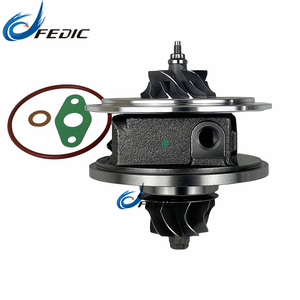(98588 products available)
















































































































































































Turbos, also known as turbochargers, are devices that compress air into the intake manifold of internal combustion engines. They compress air to increase its pressure and temperature, allowing more air and fuel into the engine's cylinders. This process results in more power from the engine without increasing its size. There are two main types of turbos:
Single Turbo
Single turbos are the most common type of turbocharged engine. They utilize a single turbocharger to boost the engine's performance. A single turbo works by using exhaust gases from the engine to spin a turbine, which then compresses air into the engine's intake manifold. By forcing more air into the engine, a single turbo increases power output without the need for a larger engine. Single turbos are widely used in both gasoline and diesel engines, offering a good balance of improved performance and fuel efficiency compared to naturally aspirated engines. The size and design of the single turbo can vary depending on the specific performance goals and engine characteristics. Single turbos are often favored by enthusiasts looking for a cost-effective and relatively simple way to gain extra power and acceleration from their vehicles. They provide a noticeable boost in performance, making driving more enjoyable and responsive.
Duo Turbo
Dual turbos, also known as twin-turbochargers, utilize two turbochargers instead of one. Twin turbos are commonly found in high-performance engines. The primary advantage of dual turbos lies in their ability to generate smoother and more powerful power delivery across the entire RPM range. The presence of two turbochargers allows for more precise control of boost levels and airflow, resulting in improved throttle response and increased power at both low and high engine speeds. Dual turbos excel in maximizing engine efficiency and performance, making them a popular choice for supercars, sports cars, and high-performance vehicles. The use of twin turbos contributes to better overall drivability, making the engine feel more responsive and delivering a thrilling driving experience. It's worth noting that dual turbos tend to be more complex and expensive compared to single turbo setups. However, the benefits in terms of power, performance, and drivability make dual turbos an attractive option for those seeking exhilarating speed and acceleration from their vehicles.
There are various specifications for turbos in the aftermarket, composed of several parts with differing functionalities and purposes.
Turbine Housing:
Generally, turbine housing is made from cast iron or stainless steel. It is available in several sizes to suit different applications. The size ranges from 0.64 to 1.06 A/R.
Compressor Housing:
The compressor housing is made from aluminum or cast iron and contains the compressor wheel. Its size depends on the turbine housing and ranges from 3.0 to 4.0 inches in diameter.
Wastegate:
There are two types of wastegates; internal and external, and both are found in different sizes. The internal wastegate is about 25-30mm in diameter, while the external one is 38-40mm in diameter. Regardless of the type, the wastegate is made from steel or aluminum.
Blow-off valve:
The blow-off valve is usually 25-32mm in diameter and is made from brass, aluminum, or steel.
Actuator:
The actuator is manufactured from steel, aluminum, and plastic. It comes in different types, including pneumatic, electric, and hydraulic. The actuator also has spring options with different spring rates, which are measured in pounds or newtons.
Oil Supply Line:
The oil supply line is made from steel tubing and has a diameter of about 6-8mm. It is responsible for delivering oil from the engine to the turbo. The line is designed to handle high pressure and temperatures.
Oil Return Line:
Like the oil supply line, the oil return line is made from steel tubing and has a diameter measuring 8-10mm. It returns oil from the turbo to the engine.
Cooling Line:
The cooling line is made from high-strength materials. For example, it is made of steel, aluminum, and rubber. It has a diameter of about 6-8mm and is used to transfer coolant from the engine to the turbo.
Turbo Timer:
The turbo timer comes in different types, such as digital or analog, and is made from various materials, including plastic, aluminum, and steel. It has a timer range of about 0-10 minutes.
Electric Actuator:
The electric actuator is typically made from plastic and steel. It also comes in different types, such as electric, pneumatic, and hydraulic. The electric actuator has a voltage of about 12-14 volts.
Maintaining turbos for sale is essential for improving their lifespan and ensuring they run optimally. Here are some maintenance tips:
1. Regular Oil Changes:
Changing the oil regularly keeps it clean by removing any accumulated debris or dirt. The clean oil lubricates the moving parts of the turbo, ensuring they do not wear out or damage.
2. Cool Down the Engine:
After using the car, it is important not to turn off the engine immediately. The turbo should be given time to cool down so that it does not get damaged.
3. Inspect the Turbo:
Regular inspection of the turbo helps identify any problems early. Look out for any unusual noises, warning lights, or performance issues. If there is a problem, consult an expert to fix it.
4. Replace Worn Parts:
Worn parts like the oil supply line and cooling line should be replaced immediately to prevent damage to the turbo.
5. Keep it Clean:
Cleaning the turbo ensures that no dirt or debris clogs it or interferes with its functioning. Use a clean cloth to wipe the exterior of the turbocharger.
6. Use Quality Oil:
Using quality oil in the turbo is important since it lasts longer and maintains its properties. The oil also lubricates the moving parts of the turbo.
When looking for turbos for sale, there are several factors to consider to ensure the right choice is made. These include:
Brand Reputation
Selecting a reputable brand is essential when choosing a turbo. This is because reputable brands offer better quality and durability.
Engine Compatibility
When choosing a turbo, ensure that the turbo is compatible with the engine. This is because using a turbo that is not compatible with the engine will result in poor performance and damage to the engine.
Size and Specs
Consider the size and specifications of the turbo. Larger turbos offer more power, while smaller turbos provide better efficiency.
Quality
Quality is an important factor to consider when choosing a turbo. High-quality turbos offer better performance and are more durable.
Budget
There are turbos available in different price ranges. It is important to set a budget before going to the market to look for a turbo.
Purpose
Decide the purpose of the turbo. This is because the purpose will determine the type of turbo to go for. For instance, if high performance is needed, a high-boost turbo is the right choice. If efficiency is the main goal, a smaller turbo will do.
Replacing a turbocharged system can be complex, but with the right tools and knowledge, it can be done. Here is a simple guide on how to replace a turbo:
Tools Needed:
Steps:
Q1: How long does a turbo last?
A1: Generally, a properly maintained turbo can last from 150,000 to 250,000 miles. However, the longevity of the turbo can be affected by several factors. These include driving habits, oil quality, and the type of turbocharger.
Q2: What causes turbos to fail?
A2: Turbo failure can be caused by many factors. Some of the common causes include oil starvation, oil contamination, foreign object damage, and normal wear and tear. These causes can reduce the turbo's lifespan.
Q3: Can beginners install a turbo by themselves?
A3: With the right knowledge and instructions, it's possible for beginners to install a turbo. However, the process is complicated. It requires mechanical expertise. Beginners without mechanical expertise might find it difficult to install a turbo by themselves.